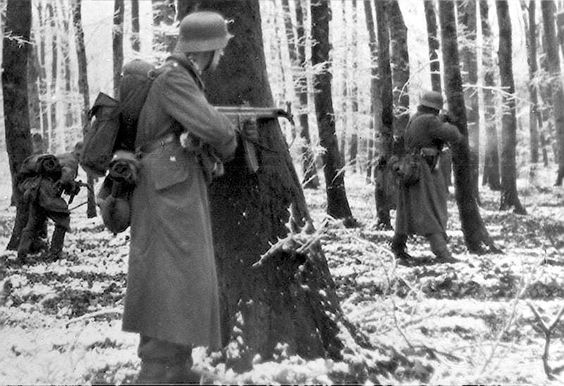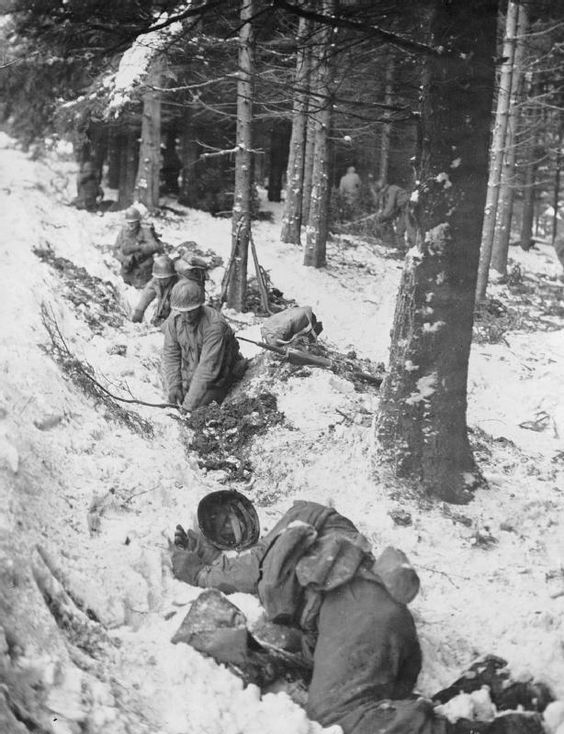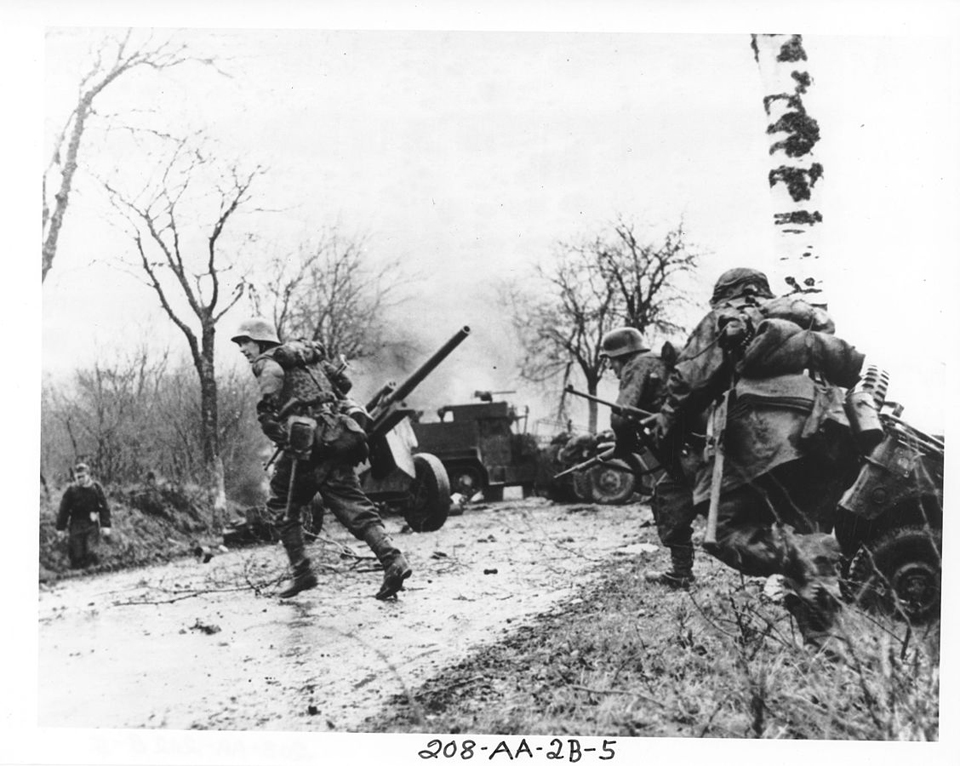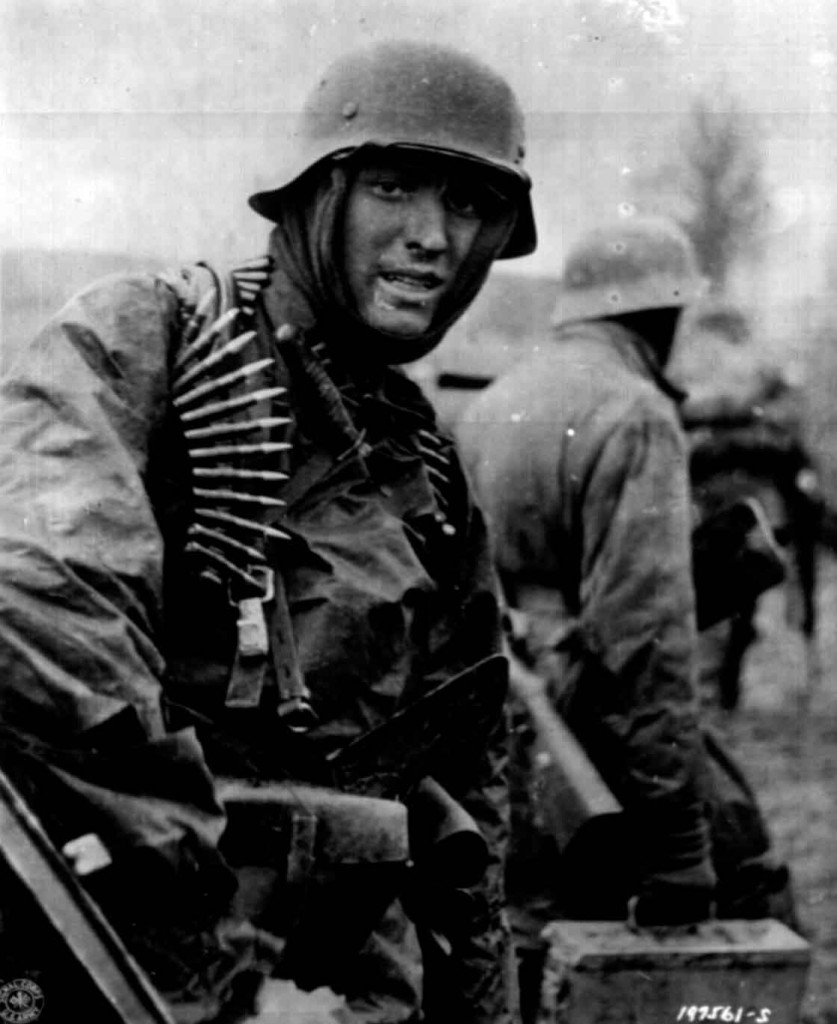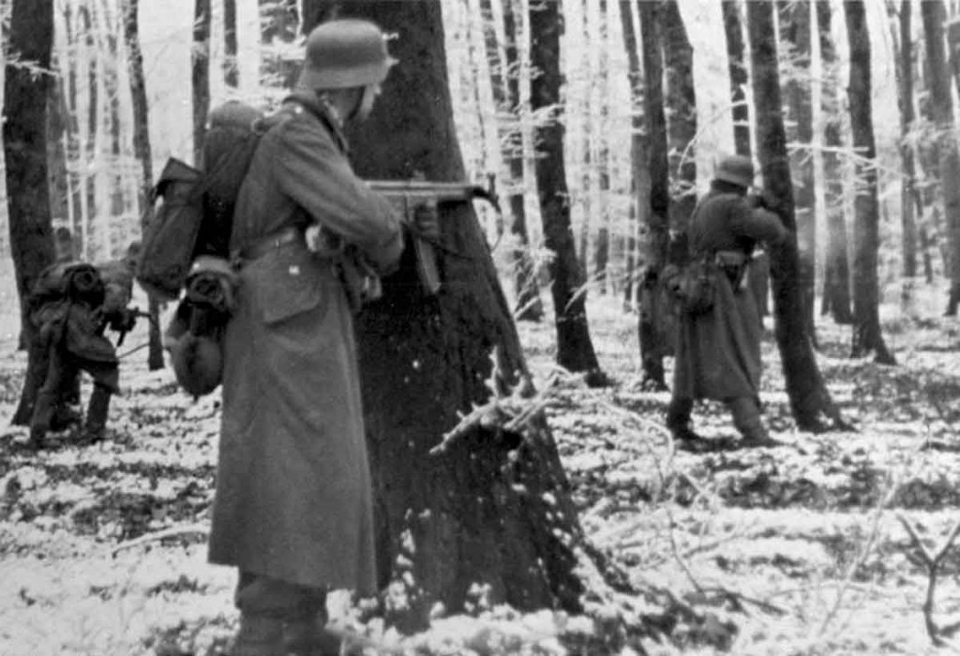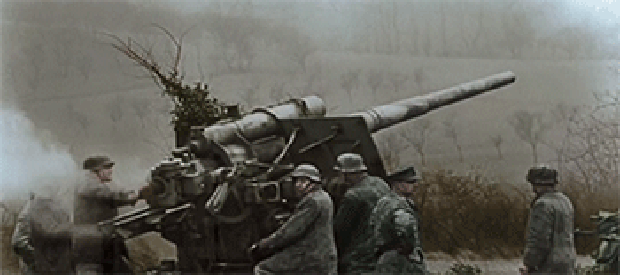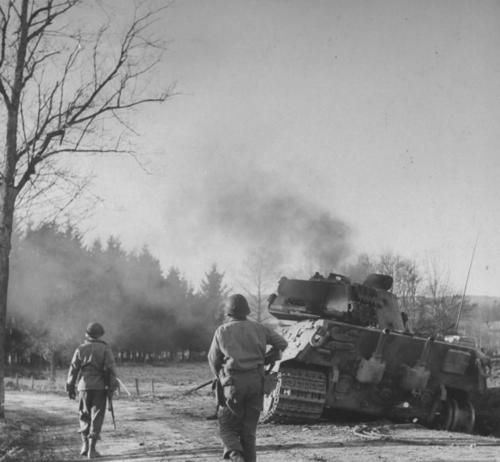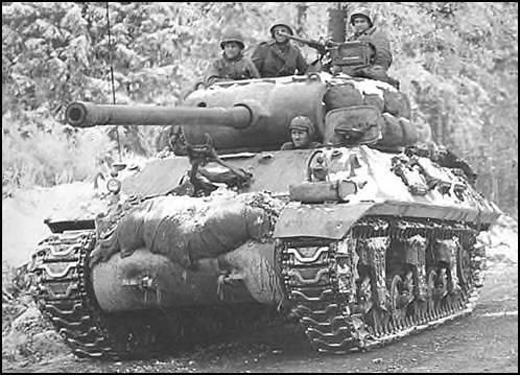Air Operations, CBI
BURMA- 10th Air Force fighter-bombers attack troops, rail facilities, and occupied towns.
- 4 P-47s support US Army ground troops near Tonkwa.
- 14th Air Force transports airlift Chinese Army ground troops to Kunming to help defend the key city against an ongoing Japanese Army ground offensive.
Air Operations, East Indies
- FEAF B-25s, A-20s, and fighter-bombers attack airfields and shipping in the Molucca Islands and targets of opportunity in northern Borneo.
- 18th Fighter Group P-38s down 2 Ki-48 'Lily' bombers and a Ki-45 'Nick' fighter near the Jesselton airfield on North Borneo at 1100 hours.
Air Operations, Europe
The main weight of the V-weapon offensive is switched from London to Antwerp. A V-2 kills 271(? - when?) in the Rex Cinema.
RAF BOMBER COMMANDDaylight Ops:
- The great German offensive in the Ardennes started on this day, with the object of capturing Brussels and the port of Antwerp and splitting the Allied armies into two parts. The attack was launched under cover of poor weather conditions, with low cloud and mist, and it would be several days before the RAF and American bomber forces could intervene in the battle.
- 108 Lancasters of No. 3 Group are on a G-H raid to the railway yards at Siegen. The bombing is accurate enough to hit Siegen and the neighbouring town of Weidenau, but not to destroy the railway yards which are hit by only a few bombs. Many public buildings and houses are destroyed in Siegen, which has not been bombed seriously before.
- 1 Lancaster is lost.
- 1 Hudson makes a Resistance flight.
Minor Ops:
- 1 Mosquito attempts to bomb Wiesbaden, but does not reach the target, and 2 Wellingtons make RCM sorties.
- There are no losses.
GERMANY:
- Of 236 3rd Bomb Division B-17s dispatched, 81 attack a marshalling yard at Stuttgart and 33 attack the town of Bietingheim. The rest abort due to bad weather.
- 1 B-17s is lost; no losses among the 116 VIII Fighter Command escorts.
ETO:
- 9th Air Force fighters and fighter-bombers support the US 1st Army in the Ardennes region along the German-Belgian frontier.
- During the night, despite horrendous weather conditions, P-61 crews of the IX TAC's 422nd Night Fighter Squadron dwon 5 Luftwaffe aircraft over eastern Belgium and western Germany.
ITALY:
- XXII TAC P-47s attack rail lines in Brenner Pass, gun emplacements, defended buildings, three vessels at La Spezia, and several rail bridges.
AUSTRIA:
- 15th Air Force B-17s and B-24s attack a benzol plant at Linz and marshalling yards at Innsbruck and Villach.
- 15th Air Force B-17s and B-24s attack an armaments factory at Pilsen and a synthetic-oil plant at Brux.
Air Operations, New Guinea
FEAF aircraft attack targets of opportunity in bypassed areas of the Vogelkop Peninsula.
[Air Operations, Philippines
- Task Force 38 carrier aircraft mount intense attacks against airfields and other military targets on Luzon and continue around-the-clock patrols over all the islandís airfields; Task Group 77.12 TBMs and FM fighter-bombers sweep Japanese airfields on Mindanao, Negros, Palawan, and Panay, cover the Mindoro invasion flotilla, and provide support for US Army ground forces on Mindoro. FEAF B-24s attack the Padada airfield on Mindanao and the Puerto Princess airfield on Palawan. Various 4th Air Force aircraft attack targets in the central Philippines.
- In 3 days of continuous patrols over Luzon airfields, Task Force 38 carrier aircraft have destroyed an estimated 208 Japanese aircraft on the ground and 72 in the air. The Big Blue Blanket is withdrawn from over the Luzon airfields when it is determined that no flyable Japanese aircraft remain to use them. In all during the 3-day operation, carrier fighters have undertaken 1,427 sorties and carrier bombers have mounted 244 sorties and dropped 336 tons of bombs. Task Force 38 losses are 27 aircraft in combat and 38 in operational accidents. Carrier aircraft are also credited with sinking as many as 4 freighters and a large Japanese Navy landing ship in Manila Bay.
- A VF(N)-41 F6F downs an E13A 'Jake' reconnaissance plane and a fighter over Cavite Point, Luzon, at 0145 and 0150 hours, respectively.
- A VF(N)-41 F6F downs a Ki-57 'Topsy' transport plane over Luzon at 0450 hours.
- A VC-81 FM downs a J1N 'Irving' fighter over Mindoro at 0715 hours. VF-7, VF-11, and VF-20 F6Fs down 5 A6M Zeross, 1 Ki-43 'Oscar' fighter, 1 Ki-61 'Tony' fighter, 1 Ki-44 'Tojo' fighter, 2 P1Ys 'Galaxy' bomber, and 3 G4M 'Betty' bombers near Baler Light, Luzon, between 0735 and 0745 hours.
- 2 VC-75 FMs down an E13A 'Jake' reconnaissance plane 20 miles from a US convoy at 0804 hours.
- 2 VC-27 FMs down an E13A 'Jake' reconnaissance plane at sea at 1010 hours.
- A VF-11 F6F downs a Ki-21 'Sally' bomber near San Fernando, Luzon, at 1500 hours.
- A VC-81 FM downs a D3A 'Val' dive bomber over a friendly convoy off Negros at 1715 hours.
- A VC-80 FM downs an A6M Zero over the Mindanao Sea at 1745 hours.
- Task Group 77.12 escort carriers retire to the Palau Islands to replenish. In four days off Mindoro, the escort-carriers have mounted 94 TBM sorties and 770 FM sorties. 8 aircraft have been lost in operational accidents and 1 FM and its pilot have been lost in combat.
- In the evening, Task Force 38 interrupts its pre-invasion attacks against Luzon in order to sail eastward to refuel.
Burma
In the British IV Corps sector, the 19th Indian Div occupies Pinlebu and Banmauk. Some units reach Indaw, making contact with the British 36th Div coming from the north.
[China
The Chinese 57th Div has not yet been transferred to the Kunming area. Gen Albert C. Wedemeyer protests to Chiang Kai-shek, who agrees that a part of the army may be air-lifted.
The protracted and difficult negotiations between Chinese Nationalists and Communists, represented by Chou En-lai, over increased co-operation in the struggle against the Japanese are finally concluded.
[Eastern Front
THE WESTERN FRONTThe last German offensive in the west begins as Hitler launches his Ardennes thrust. Bitter fighting until the end of January 1945 will cost Germany valuable soldiers and vehicles and huge stocks of fuel.
[Italy
Gen Harold Alexander, promoted Field-Marshal, is appointed Supreme Allied Commander, Mediterranean, replacing Gen Maitland Wilson. Gen Mark Clark is appointed Commander-in-Chief of Allied forces in Italy, 15th Army Group, in his place, and command of the US 5th Army passes to Gen Lucian Truscott.
In the 8th Army sector, Faenza is taken by units of the British V Corps. The New Zealand 2nd Div reaches the Senio River and the 10th Indian Div enters Pergola.
[Pacific
- The US submarine Finback (SS-230) attacks a Japanese convoy about 50 miles northwest of Chichi Jima and sinks the transport Jusa Maru (2111t).
- The British submarine Stoic sinks the Japanese gunboat Shoei Maru (1986t) west of Sunda Strait.
Philippines
There is considerable air activity with the Japanese attacking American shipping and the Americans replying with strikes against the Japanese air bases.
On Mindoro the Americans confine their activity to patrolling their perimeter and fortifying the area around the airfield they are constructing.
Aircraft of the US 3rd Fleet continue their attacks on military targets on Luzon.
On Leyte the US 77th Division takes Cogon and San Jose, resuming their advance north of Ormoc. The 2nd Battalion of the 32nd Infantry Regiment begins moving into the mountains from Ormoc Bay to link up with the paratroopers from the 11th Airborne Division making a cross-country advance to clear out the last organized Japanese defenders.
[Sumatra
British carrier aircraft bombard Japanese oil installations at Belawan-Deli.
V-Weapons
A German V-2 rocket from Enschede, Netherlands, hita a movie theater in Antwerp, killing 567 people including 296 British servicemen.
[Battle of the Bulge
Western Front
The Germans begin a major offensive in the Ardennes. The Ardennes battle is often popularly styled the Battle of the Bulge. The attack begins with a short, sharp artillery barrage along the chosen front between Monshau and Trier. Almost complete surprise is achieved. Allied intelligence has received some indications of the attack despite elaborate security on the German side but these signs have not been interpreted properly. Partly because of the enforced shortening of their front the Germans have been able to assemble a considerable reserve of armored divisions. They have chosen to strike here with the immediate aim of retaking Antwerp and splitting the British and American armies in two. In the longer term Hitler hopes to discourage and divide the British and Americans politically so that forces can be switched to the Eastern Front, perhaps even with help from anti-communist leaders who may emerge in Britain and America. Altogether the Germans have assembled 24 divs, including 10 armored. These forces are distributed largely between Sepp Dietrich's 6th SS Pzr Army and Hasso von Manteuffel's 5th Pzr Army. On the flanks of the attack are 15th and 7th Armies. All these forces are part of Walter Model's Army Group B. Gerd von Rundstedt has been brought back to have overall charge of the operation. To oppose the German forces are about 6 American divisions from V and VIII Corps consisting partly of inexperienced troops and partly of resting veterans. The terrain here in the same Ardennes area, as was chosen for the start of the attack in 1940, is fairly rugged with many defiles and much heavily wooded country. Most of whatever movement is attempted must take place on the few major roads so, as will emerge, it is vital to seize the various junctions. The Germans hope to spread confusion in the American rear areas by infiltrating small groups of specially trained English-speaking troops with captured uniforms and equipment to perform sabotage and intelligence missions. This move is very successful at least in causing an atmosphere of suspicion and uncertainty. Many roadblocks and checkpoints are set in the American rear areas and they do something to hinder the movement of reserves.
The Germans are relying on bad weather to keep the Allied air forces grounded and for the moment this hope is fulfilled.
In the first day of the attack the Germans succeed in disrupting the Allied front and make good ground in many sectors.
The 95th Div continues to extend its bridgehead at Saarlautern. During the night its units begin to be relieved by the 5th Div. The area between the XX and XII Corps is allocated to the II Corps. The XII Corps continues its attacks against the outer defenses of the Siegfried Line, but these are suspended when news is received of the German offensive in the Ardennes. In the south, the VI Corps, US 7th Army, sends its divisions forward toward the German frontier.
[Images from December 16, 1944
|
|
|
|
|
|
|
|
